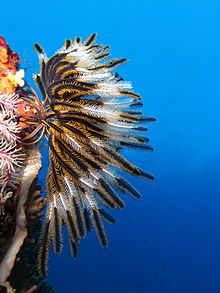Crinozoa
This articleneeds additional citations forverification.(August 2023) |
| Crinozoa Temporal range:
| |
|---|---|

| |
| Crinoid on the reef of Batu Moncho Island,Indonesia | |
| Scientific classification | |
| Domain: | Eukaryota |
| Kingdom: | Animalia |
| Phylum: | Echinodermata |
| Subphylum: | Crinozoa Matsumoto 1929 |
| Classes | |
| |
Crinozoais a subphylum of mostlysessileechinoderms,of which thecrinoids,or sea lilies and feather stars, are the onlyextantmembers.[1][2]Crinozoans have an extremely extensive fossil history, which may or may not extend into the Precambrian (provided the Enigma ticEdiacaranArkaruacan be positively identified as an edrioasteroid).
Classes within Crinozoa
[edit]The classes currently contained within Crinozoa includeCrinoideaand the extinctParacrinoidea(Cystoidea,Edrioasteroidea,andRhombifera).[2]
Regeneration
[edit]Since the Paleozoic, sea lilies, or crinoids, have been able to regenerate and undergo arm autotomy or the intentional amputation of a limb. The sea lily can regenerate all of its arms at once in addition to its entire crown. Their stalk's uppermost segment and the basal plates have the capacity to regenerate the entire crown. Nutrients and other components from the stalk, especially the upper 5 cm, are used by crown regeneration.[3]
See also
[edit]- List of echinoderm orders
- Blastoids,superficially similar-appearing echinoderms that belong to a different echinoderm subphylum.
References
[edit]- ^Newton, Alisa L.; Dennis, Michelle M. (2021-03-23), LaDouceur, Elise E.B. (ed.),"Echinodermata",Invertebrate Histology(1 ed.), Wiley, pp. 1–18,doi:10.1002/9781119507697.ch1,ISBN978-1-119-50765-9,S2CID261009894,retrieved2023-08-04
- ^ab"WoRMS - World Register of Marine Species - Crinozoa".marinespecies.org.Retrieved2023-09-16.
- ^Amemiya, Shonan; Oji, Tatsuo (June 1992)."Regeneration in sea lilies".Nature.357(6379): 546-547.Bibcode:1992Natur.357..546A.doi:10.1038/357546a0.ISSN1476-4687.
